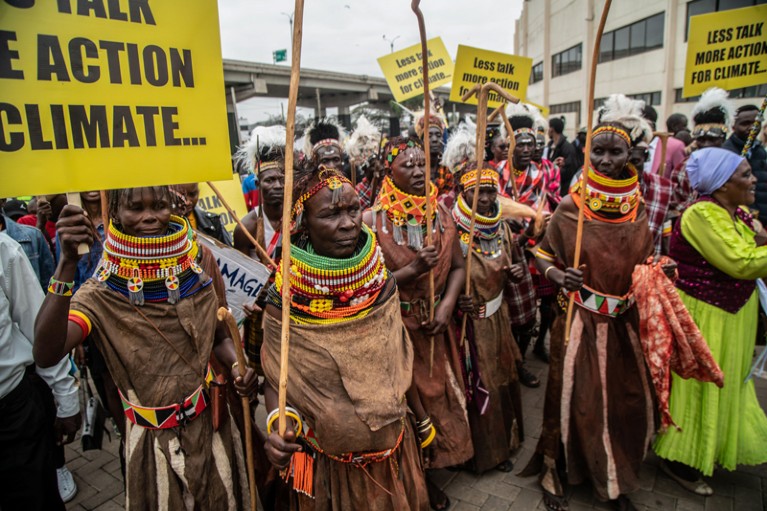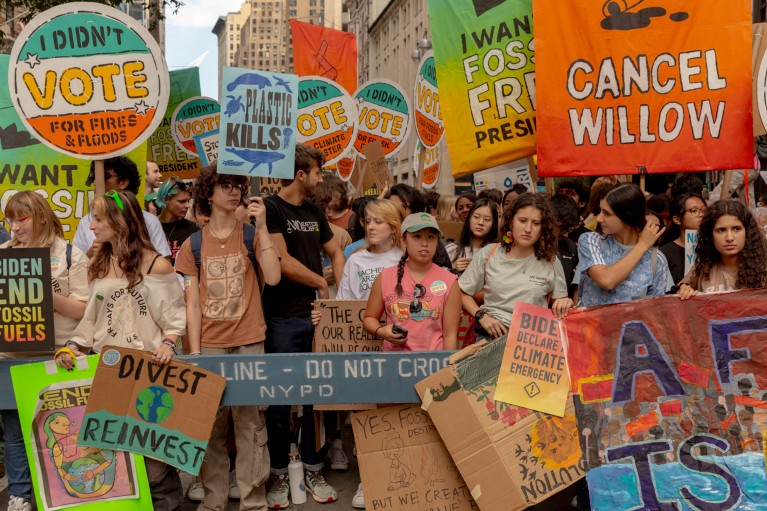As yet another United Nations climate summit approaches in the shape of COP28, which kicks off in Dubai this week, signs of public exasperation with the failure of climate policymaking are plain to see. After three decades of negotiations, greenhouse-gas emissions are still rising and time is running out to stop global heating from reaching catastrophic levels1. In response, people around the world are trying to work out how best to get their voices heard.
September, for example, saw protests across more than 65 countries. Demonstrators demanded “less talk, more action” outside the first Africa Climate Summit in Nairobi, Kenya — a nation where climate change has already exacerbated insecurities in water and food supplies. In Libya, where flooding killed thousands of people after dams burst, protesters demanded accountability. Worldwide, more than 600,000 people took part in actions linked to the Global Fight to End Fossil Fuels, including 75,000 people marching in New York City.
Marching in the streets for climate-crisis action
Protest and activism have the potential to motivate the type of “rapid, disruptive and transformative changes” that the Intergovernmental Panel on Climate Change (IPCC) has called for to address climate change2. Social movements will play an important part in achieving a sustainable future for people and nature. Indeed, one would be hard pressed to think of historical examples of transformative progressive change that did not involve activism.
But how does a movement best effect change and convert citizens’ concerns into policies that address the problem? To answer that in the case of climate activism requires further research in three key areas: what motivates some people to join protests while others do not? What are the pros and cons of the tactics that protesters use? And what can researchers do to understand and counter the increasingly repressive measures being used against climate activists in many parts of the world?
What drives people to become climate protesters?
Research has revealed many, often overlapping, reasons why individuals demonstrate and join social movements3: attempting to voice a political message, expressing anxiety or concern about a situation, seeking to build a movement aimed at deeper societal transformation or asserting their group identity. Such diversity was tangible, for example, among the people who joined the March to End Fossil Fuels in New York City on 17 September — the largest climate-focused protest in the United States in years, where one of us (D.R.F.) spent the day in the crowd talking to participants.
In the march, clusters of young people were interspersed with groups of older activists, who related how the climate crisis had brought them back on to the streets for the first time since the Vietnam war protests in the 1970s. Young members of the Sunrise Movement — a US group calling for political action to achieve a Green New Deal — marched through the crowd chanting with a megaphone: “they try to stop us, but we keep coming back.”

People in Derna, Libya, called for government accountability after floods killed thousands.Credit: Zohra Bensemra/Reuters
But what factors determine who takes to the streets over climate change? Studies show that individuals who experience psychological distress about the climate crisis are more likely than others to take action (see go.nature.com/3syscj7). At the New York City march, D.R.F’s survey of 170 randomly sampled participants provided more evidence. A majority reported strongly or very strongly experiencing sadness (81%) or anger (75%) in relation to climate change. For many, those emotions were associated with their lived experience in the previous six months: 87% reported having personally experienced extreme heat, 85% had been affected by wildfires or smoke from wildfires, and 60% by frequent and powerful storms (for a summary, see go.nature.com/3unvs9d).
Researchers know much less about the thresholds for mobilization. What are the tipping points that transform individuals from sympathizers of a movement to activists within it? For example, what parts do people in social networks or personal connections to civic and environmental organizations play?4 How does emotion affect the tactics an activist chooses? Barriers to joining movements also need to be examined; for example, whether they are largely systemic (reflecting a lack of time or capacity among people who are genuinely concerned) or psychological (individuals being reluctant to identify as an activist because of negative stereotypes).
What tactics should activists choose?
Protesters have a broad choice of tactics. Political scientist Gene Sharp listed 198 methods of non-violent direct action5, and climate activists have drawn on many of them. Not only do protesters march in the streets and sit in public squares, but they also march slowly, throw food or paint and block roads or access to buildings and pipeline projects. They might also disrupt sporting and cultural events, disrobe in public, block the distribution of newspapers and even engage in hunger strikes and self-immolation.
Major US climate disasters occur every three weeks, report finds
It is rare for any of these tactics to influence public policy directly, however. Successful examples include the global wave of protests in 2011 that challenged the inevitability of economic austerity, which led to stronger institutional contestation of austerity in countries and municipalities across Europe6, and the Black Lives Matter protests after George Floyd was murdered in 2020, which led to changes in the ways cities and states police the public7.
Protesters cannot tell people what to think, but they might be able to influence what people are thinking about. Moreover, protests can set news agendas8. When a UK poll in June 2019 found that the environment appeared in the public’s top three issues for the first time, the pollsters YouGov concluded that the “sudden surge in concern is undoubtedly boosted by the publicity raised for the environmental cause by Extinction Rebellion” — an activist group that had occupied prominent central London sites for two weeks around that time (see go.nature.com/3uaprq5). A similar effect was seen in the months after protests by Insulate Britain, a campaign group advocating government action to improve home insulation and save energy, began in September 2021: the number of mentions of the word ‘insulation’ (but, notably, not ‘insulate’) in the UK print media doubled (see go.nature.com/47g6twr). People took notice of the issue, if not the specific climate group.
However, rallies and marches alone — even those with high attendance — are generally not seen as newsworthy9. News media are more likely to report on protests that include some sort of disruption or shocking action, such as defacing a building, a fountain or a work of art. As a co-founder of Extinction Rebellion put it: “Only through disruption, the breaking of laws, do you get the attention you need.”10

Protesters outside the first Africa Climate Summit in Nairobi in early September.Credit: SOPA Images Limited/Alamy
The shift to confrontational tactics is a common trajectory for a social movement. When some participants perceive that they do not have enough access to power to make change through the legal and political systems, they decide to get more disruptive and form a ‘radical flank’11. The women’s movement and the US civil-rights movement are well documented to have included radical elements that co-existed alongside moderate ones working to effect social change11,12.
Yet confrontational tactics are also often unpopular. Opinion polls show that only 10–20% of a sample of the British and German populations hold a positive opinion of climate groups, such as Just Stop Oil and Letzte Generation, that have used disruptive protests over the past two years (for polling data, see https://osf.io/r2qhn). Less is known about how different types of activist tactic affect public attitudes.
The unpopularity of confrontational protest stems not just from its illegality, but also from its often unclear logic. Blocking oil terminals is easy to explain — the means and ends are congruent13. Soup-throwing and road-blocking, by contrast, are performative — they are stunts designed to attract the media, but are not directly connected to the goals of the protesters and come across as incongruent.
Some scholars argue that groups face an ‘activist’s dilemma’, in which they must make a conscious choice between their desire to attract media attention and their popularity14. But the importance of popularity is often exaggerated and in itself is not an aim for protesters15: they are, after all, not running for election. The public might see confrontational activism as a nuisance, but it is wrong to assume that unpopular actions turn people away from the cause. Experiments show that people’s attitudes to an issue and to a group’s demands are distinct from, and not determined by, how they feel about the group and its tactics (see go.nature.com/47g6twr).
Disaster early-warning systems are ‘doomed to fail’ — only collective action can plug the gaps
YouGov polling across Europe documents that there has been little shift in public opinions around climate change since the large 2019 protests raised awareness (see go.nature.com/3sg8sgg). Thus, so far, confrontational climate activism has neither deterred nor encouraged the general public. The real dilemma is that it is difficult to recruit large numbers to join risky and unpopular disruptive protests, and the increased publicity does not necessarily translate into greater public concern. There is reason to think that both large numbers and disruptive actions are necessary components for more direct outcomes from climate protest, although more research is needed in this area.
Researchers therefore need to explore in more detail the specific impacts of particular protest tactics. Are some more effective than others in provoking behavioural change, and in what contexts? What are the pros and cons of narrow or broad demands?
For example, Insulate Britain made a clear, narrow demand aimed at reducing emissions by insulating social housing. By contrast, Extinction Rebellion has avoided making specific policy demands, preferring to advocate much broader changes in democratic governance, notably through the use of citizens’ assemblies to decide on policy questions. Narrow demands are easier to convey and achieving success can attract more activists. But they might not be as effective in communicating a positive vision of a future in which the worst impacts of the climate crisis are avoided.
What motivates repression of protests?
The natural trajectory of a social movement that has not yet achieved its goals is to lose popularity (the issue goes away or public interest wanes) or to become increasingly confrontational until its demands are met. There are numerous historical examples. Decades into the struggle for women’s suffrage, which started in the nineteenth century, for instance, the suffragettes were undertaking, on average, 20 bombings and arson attacks per month in 191316.
By comparison, contemporary climate activism seems rather mild. Yet that could change as more people become personally affected by climate impacts and as political demands remain unmet.
Meanwhile, the political climate for such activism is becoming increasingly hostile, to the point at which some governments seem more concerned with criminalizing non-violent protesters than acting on climate. In the past two years, for example, the United Kingdom has increased maximum sentences as well as police and government powers to declare protests illegal. And globally, there is a wave of similar anti-protest legislation, with more draconian sentencing and laws to curb protests. Such moves have been called out by UN secretary-general António Guterres. In April 2022, he declared that “the truly dangerous radicals are the countries that are increasing the production of fossil fuels”.
Young people’s climate anxiety revealed in landmark survey
There is growing evidence that this wave of legislation is not driven by public opinion. Two of us (C.J.D. and O.B.) have run polls in the United Kingdom and Germany showing that less than one-third of people surveyed want to see non-violent protesters imprisoned (for polling data, see https://osf.io/r2qhn). Researchers need to explore what is driving this policy trend, including the actors involved and the role of the fossil-fuel lobby. Such pressures are likely to grow as more people are affected by climate change, and as vested interests that benefit from fossil-fuel expansion operate inside and outside political systems to stop protesters drawing negative attention to their work.
In 2021, 400 academics working in climate-related fields pointed out in an open letter that combating the criminalization of protest is an essential part of the fight for a habitable planet (see go.nature.com/3mskd9d). As the climate crisis worsens, climate activism and its repression will become increasingly common. Research is needed to understand how climate activism could provide a more effective conduit for channelling public concerns to policymakers and changing policies. Although we cannot predict how bad the climate crisis will get15, research has the potential to provide valuable insights into how civil society and social movements can enable the transitions required to respond meaningfully to the crisis.


 Protect the ‘right to science’ for people and the planet
Protect the ‘right to science’ for people and the planet
 Young people’s climate anxiety revealed in landmark survey
Young people’s climate anxiety revealed in landmark survey
 Disaster early-warning systems are ‘doomed to fail’ — only collective action can plug the gaps
Disaster early-warning systems are ‘doomed to fail’ — only collective action can plug the gaps
 Marching in the streets for climate-crisis action
Marching in the streets for climate-crisis action
 Major US climate disasters occur every three weeks, report finds
Major US climate disasters occur every three weeks, report finds
 Outcry as scientists sanctioned for climate protest
Outcry as scientists sanctioned for climate protest
 Why I broke the law for climate change
Why I broke the law for climate change





